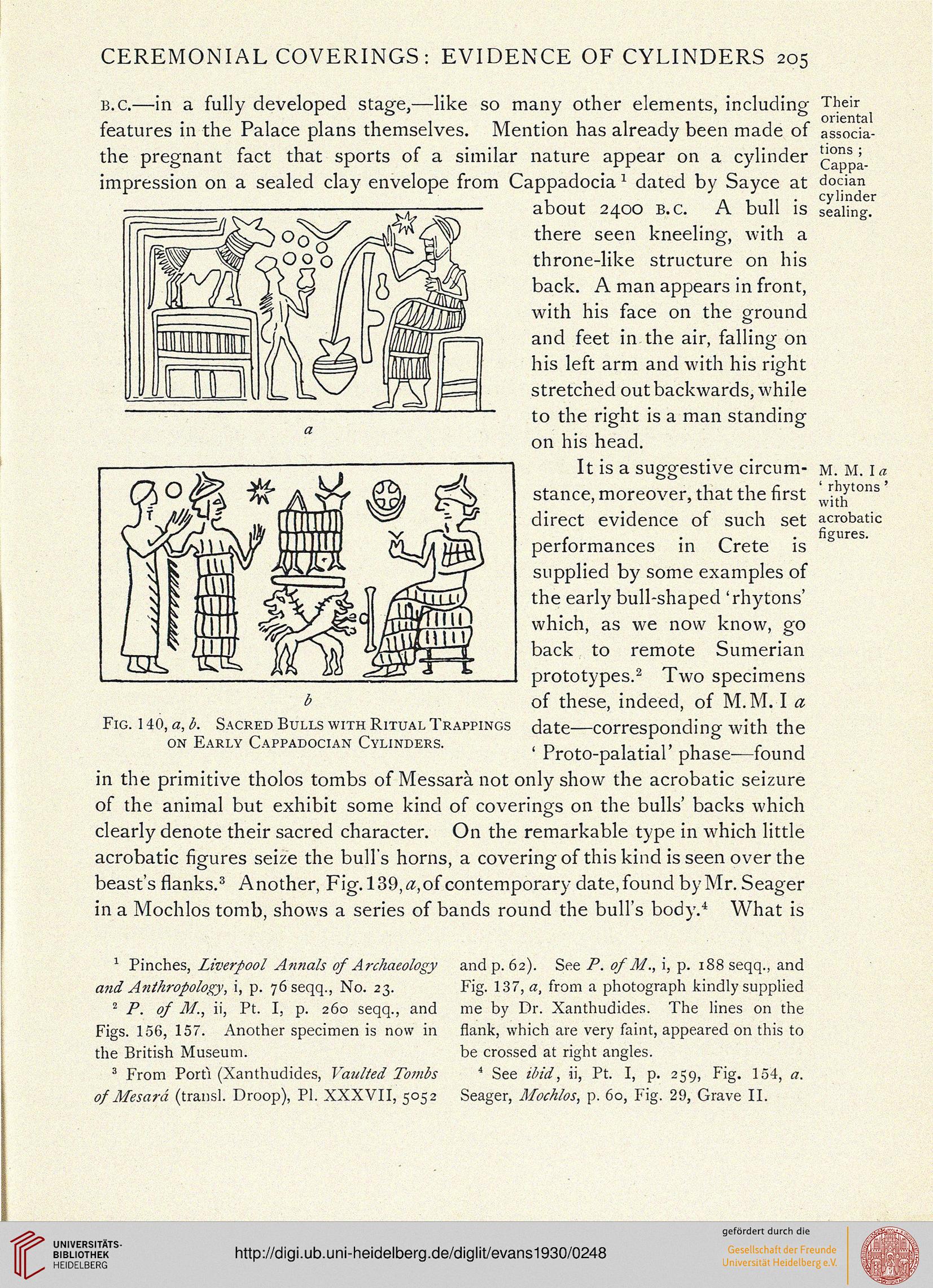CEREMONIAL COVERINGS: EVIDENCE OF CYLINDERS 205
B.C.—-in a fully developed stage,—like so many other elements, including
features in the Palace plans themselves. Mention has already been made of
the pregnant fact that sports of a similar nature appear on a cylinder
impression on a sealed clay envelope from Cappadociax dated by Sayce at
about 2400 B.C. A bull is
there seen kneeling, with a
throne-like structure on his
back. A man appears in front,
with his face on the ground
and feet in the air, falling on
his left arm and with his right
stretched out backwards, while
to the right is a man standing
on his head.
It is a suggestive circum-
stance, moreover, that the first
direct evidence of such set
performances in Crete is
supplied by some examples of
the early bull-shaped 'rhytons'
which, as we now know, go
back to remote Sumerian
prototypes.2 Two specimens
of these, indeed, of M. M. I a
date—corresponding with the
' Proto-palatial' phase—found
in the primitive tholos tombs of Messara not only show the acrobatic seizure
of the animal but exhibit some kind of coverings on the bulls' backs which
clearly denote their sacred character. On the remarkable type in which little
acrobatic figures seize the bull's horns, a covering of this kind is seen over the
beast's flanks.3 Another, Fig.l39,«,of contemporary date.found by Mr. Seager
in a Mochlos tomb, shows a series of bands round the bull's body.4 What is
Their
oriental
associa-
tions ;
Cappa-
docian
cylinder
sealing-.
M. M. la
' rhytons'
with
acrobatic
figures.
Fig. 140, a, b. Sacred Bulls with Ritual Trappings
on Early Cappadocian Cylinders.
1 Pinches, Liverpool Atinals of Archaeology
and Anthropology, i, p. 76seqq., No. 23.
2 P. of M., ii, Pt. I, p. 260 seqq., and
Figs. 156, 157. Another specimen is now in
the British Museum.
3 From Port! (Xanthudides, Vaulted Tombs
of Mesard (transl. Droop), PI. XXXVII, 5052
and p. 62). See P. of M., i, p. 188 seqq., and
Fig. 137, a, from a photograph kindly supplied
me by Dr. Xanthudides. The lines on the
flank, which are very faint, appeared on this to
be crossed at right angles.
4 See ibid, ii, Pt. I, p. 259, Fig. 154, a.
Seager, Mochlos, p. 60, Fig. 29, Grave II.
B.C.—-in a fully developed stage,—like so many other elements, including
features in the Palace plans themselves. Mention has already been made of
the pregnant fact that sports of a similar nature appear on a cylinder
impression on a sealed clay envelope from Cappadociax dated by Sayce at
about 2400 B.C. A bull is
there seen kneeling, with a
throne-like structure on his
back. A man appears in front,
with his face on the ground
and feet in the air, falling on
his left arm and with his right
stretched out backwards, while
to the right is a man standing
on his head.
It is a suggestive circum-
stance, moreover, that the first
direct evidence of such set
performances in Crete is
supplied by some examples of
the early bull-shaped 'rhytons'
which, as we now know, go
back to remote Sumerian
prototypes.2 Two specimens
of these, indeed, of M. M. I a
date—corresponding with the
' Proto-palatial' phase—found
in the primitive tholos tombs of Messara not only show the acrobatic seizure
of the animal but exhibit some kind of coverings on the bulls' backs which
clearly denote their sacred character. On the remarkable type in which little
acrobatic figures seize the bull's horns, a covering of this kind is seen over the
beast's flanks.3 Another, Fig.l39,«,of contemporary date.found by Mr. Seager
in a Mochlos tomb, shows a series of bands round the bull's body.4 What is
Their
oriental
associa-
tions ;
Cappa-
docian
cylinder
sealing-.
M. M. la
' rhytons'
with
acrobatic
figures.
Fig. 140, a, b. Sacred Bulls with Ritual Trappings
on Early Cappadocian Cylinders.
1 Pinches, Liverpool Atinals of Archaeology
and Anthropology, i, p. 76seqq., No. 23.
2 P. of M., ii, Pt. I, p. 260 seqq., and
Figs. 156, 157. Another specimen is now in
the British Museum.
3 From Port! (Xanthudides, Vaulted Tombs
of Mesard (transl. Droop), PI. XXXVII, 5052
and p. 62). See P. of M., i, p. 188 seqq., and
Fig. 137, a, from a photograph kindly supplied
me by Dr. Xanthudides. The lines on the
flank, which are very faint, appeared on this to
be crossed at right angles.
4 See ibid, ii, Pt. I, p. 259, Fig. 154, a.
Seager, Mochlos, p. 60, Fig. 29, Grave II.




